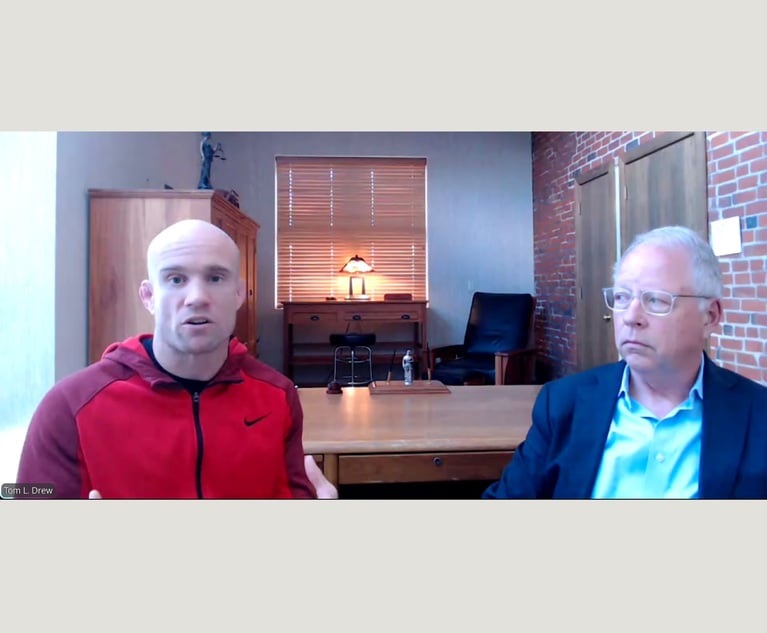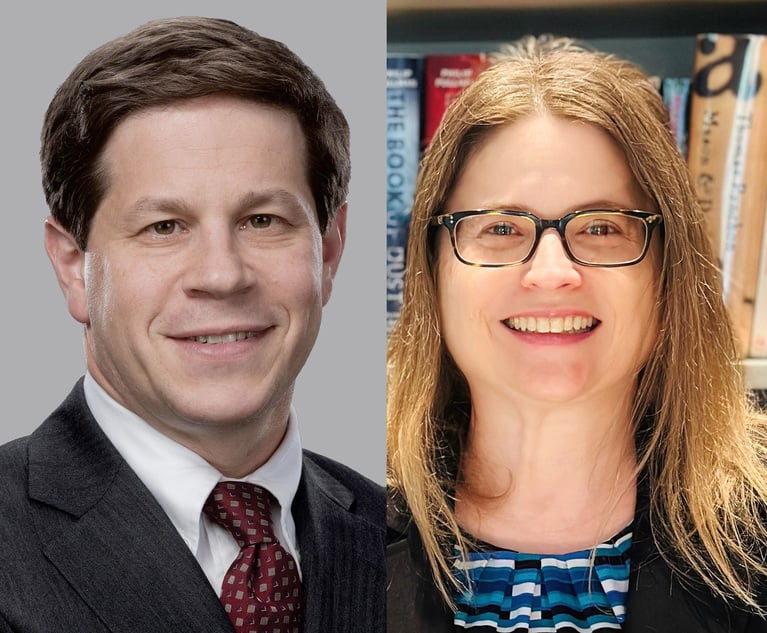 Judge Maxine Chesney for the Northern District of California, and Judge William Alsup, right, U.S. District Court for the Northern District of California. Photos: Jason Doiy/ALM
Judge Maxine Chesney for the Northern District of California, and Judge William Alsup, right, U.S. District Court for the Northern District of California. Photos: Jason Doiy/ALMTwo Judges. 60-Plus Years on the Bench. Plenty of Advice.
U.S. District Senior Judges Maxine Chesney and William Alsup spoke last month at the San Francisco federal courthouse about things they’ve picked up during their decades on the bench.
November 13, 2024 at 08:30 AM
7 minute read
Listen to the judge.
It’s a straightforward rule that applies equally to litigators and journalists covering courts.
When two judges with more than six decades of experience on the bench between them sat down at the San Francisco federal courthouse last month to dole out advice for practicing litigators, Litigation Daily was all ears. U.S. District Senior Judges Maxine Chesney and William Alsup passed along dozens of practice tips during a program sponsored by the Northern District of California Chapter of the Federal Bar Association. Here are the highlights.
|
More Isn’t Always Better
Chesney, who has been on the federal bench for more than 28 years and served on the state court bench for a dozen years prior to that, said that lawyers often have a way of over-complicating their cases. “I think people just go to Wikipedia and they go, ‘Oh, okay, I’ve got all these causes of action. I'll put them all in.’ And the defendant's going: ‘Here are all the affirmative defenses. Put all those in.’”
But Chesney said you don’t have to have 10 causes of action or defenses to put on a good case. Keeping things as simple as possible can help focus a fact-finder on your strongest arguments. “Don't cram a bunch of things into your pleading that you're trying to shoehorn your facts into,” she said. "It never works.”
Chesney also said that when it comes to motions, she thinks there's an inverse relationship between how much a party has to say and how right they are. “If you have to spend 25 pages explaining why there's no issue in a case, there's probably an issue in the case,” she said.
|
Appeal to Fairness—or Get an Airtight Set of Instructions
Alsup, who was a civil litigation partner at Morrison & Foerster prior to taking the bench 25 years ago, says that every trial is conducted on two levels: one according to the law and the other according to the equities. “You, as the trial lawyer, need to have a case on both fronts and try to win it on the instructions, but also try to win it on the equities,” he said.
Alsup said that winning on the equities means appealing to jurors’ sense of what’s fair. “Imagine if we, as the judge, were to say, ‘Ladies and gentlemen of the jury, you've heard all the evidence, go and decide this case according to what you think is fair,’” Alsup said. Although that’s not what the judge tells jurors, Alsup said it's “part of the dynamic in the courtroom” and what’s perceived as the fair outcome will play an important part in how jurors make their decisions.
What if you have a case that’s strong on the law, but not great on the equities? Alsup said that when that’s the case, as it sometimes can be on the defense side of civil cases, you want to make sure you have an airtight set of jury instructions. He said that model jury instructions often will have some wiggle room. Lawyers who have a case where the legally correct outcome may not be the most fair one will often have to ask for a special jury instruction. “This is where your credibility as a lawyer will be important,” Alsup said. “If you have squandered your credibility, you might not get that instruction. But if you have tried to earn some trust from the judge, this is where it makes a great deal of difference.”
|
Some Words and Phrases to Avoid
The judges gave a handful of words and phrases that can create problems during arguments or be the sources of disputes in and of themselves. Chesney said the word “include”—appearing either in a contract or a statute—has been problematic in multiple cases where she’s presided.
“It's ambiguous,” Chesney said. “If you use it and you make it very clear that you mean ‘but not limited to,’ it's fine. But if you use it as a substitute for ‘consisting of,’ you’ve got a problem.”
Chesney also encouraged the more senior lawyers in the audience to avoid bringing up how long they’ve been practicing during oral arguments. “Every now and then you get a lawyer who says, ‘In my 35 years of practicing law …’ and then they're going to tell you you're doing something they've never seen before,” she said. “It's not a good idea to use that on someone of my vintage, because my years are going to trump yours in almost every instance.” Chesney added that if you use that phrasing with a younger judge, “It’s just plain insulting.”
Both Chesney and Alsup echoed a message that Federal Circuit judges who heard arguments at the University of California, Berkeley School of Law imparted to students last month: don't duck hard questions. “If you get a hard question, I think it's just important to take it on,” Chesney said. She said if you feel like the answer to a question is one that’s not in your client’s favor, it’s best to concede it and move to your stronger points. But she said that if you don’t answer the question, or if you answer it by pulling the politician’s debate trick of going on a tangent, it could potentially hurt your overall argument. “If I get an answer like that, then I'm going to be very suspicious,” she said.
Alsup said in those moments the word “so” is a “dead giveaway” that whatever follows will not be responsive. He said he’ll often ask a difficult question and see the lawyer pause, look at the ceiling and say “so.”
“They launch into … their talking point that is meant to address that general subject, but it is not an answer,” he said. “Don't start your answer with the word ‘so.’ That's my advice. And at least try to answer.”
|
Don’t Write Out Your Opening or Closing
Chesney urged lawyers to avoid writing down their opening and closing statements. “If you write them out, you will read them,” she said. “Even though you say to yourself, ‘I'm not going to read them,’ you will read them.” She said those statements should be more of a conversation with jurors rather than a speech. “You want to tell them why they should vote in favor of the position that you're espousing,” she said. “If you're just reading and trying to get everything in—every little bit of evidence—that's not what's going to be important to them.”
Alsup said the same thing applies to examining witnesses on the stand. “It's okay to have to jot down short phrases to help you remember what point you wanted to make,” he said. But he said he sees litigators—especially those at large law firms—go into trial with notebooks “prepared three levels down by an associate” who just read the questions as written. “It's not just that you're reading it. It's [that] you're locked into the script,” Alsup said. The answers the witness is giving, the judge said, might mean you need to take a completely different direction in your examination. “I think you need to, with witnesses, be prepared to go off in a different direction and not be locked into a script,” he said.
NOT FOR REPRINT
© 2024 ALM Global, LLC, All Rights Reserved. Request academic re-use from www.copyright.com. All other uses, submit a request to [email protected]. For more information visit Asset & Logo Licensing.
You Might Like
View All
Helping Lawyers Move Away from ‘Grinding’ and Toward a ‘Flow’

Trying a Case for Abu Ghraib Detainees Two Decades After Abuse

Litigators of the Week: Simpson Thacher and ACLU Team To Challenge Louisiana's Ten Commandments Law
Trending Stories
Who Got The Work
Michael G. Bongiorno, Andrew Scott Dulberg and Elizabeth E. Driscoll from Wilmer Cutler Pickering Hale and Dorr have stepped in to represent Symbotic Inc., an A.I.-enabled technology platform that focuses on increasing supply chain efficiency, and other defendants in a pending shareholder derivative lawsuit. The case, filed Oct. 2 in Massachusetts District Court by the Brown Law Firm on behalf of Stephen Austen, accuses certain officers and directors of misleading investors in regard to Symbotic's potential for margin growth by failing to disclose that the company was not equipped to timely deploy its systems or manage expenses through project delays. The case, assigned to U.S. District Judge Nathaniel M. Gorton, is 1:24-cv-12522, Austen v. Cohen et al.
Who Got The Work
Edmund Polubinski and Marie Killmond of Davis Polk & Wardwell have entered appearances for data platform software development company MongoDB and other defendants in a pending shareholder derivative lawsuit. The action, filed Oct. 7 in New York Southern District Court by the Brown Law Firm, accuses the company's directors and/or officers of falsely expressing confidence in the company’s restructuring of its sales incentive plan and downplaying the severity of decreases in its upfront commitments. The case is 1:24-cv-07594, Roy v. Ittycheria et al.
Who Got The Work
Amy O. Bruchs and Kurt F. Ellison of Michael Best & Friedrich have entered appearances for Epic Systems Corp. in a pending employment discrimination lawsuit. The suit was filed Sept. 7 in Wisconsin Western District Court by Levine Eisberner LLC and Siri & Glimstad on behalf of a project manager who claims that he was wrongfully terminated after applying for a religious exemption to the defendant's COVID-19 vaccine mandate. The case, assigned to U.S. Magistrate Judge Anita Marie Boor, is 3:24-cv-00630, Secker, Nathan v. Epic Systems Corporation.
Who Got The Work
David X. Sullivan, Thomas J. Finn and Gregory A. Hall from McCarter & English have entered appearances for Sunrun Installation Services in a pending civil rights lawsuit. The complaint was filed Sept. 4 in Connecticut District Court by attorney Robert M. Berke on behalf of former employee George Edward Steins, who was arrested and charged with employing an unregistered home improvement salesperson. The complaint alleges that had Sunrun informed the Connecticut Department of Consumer Protection that the plaintiff's employment had ended in 2017 and that he no longer held Sunrun's home improvement contractor license, he would not have been hit with charges, which were dismissed in May 2024. The case, assigned to U.S. District Judge Jeffrey A. Meyer, is 3:24-cv-01423, Steins v. Sunrun, Inc. et al.
Who Got The Work
Greenberg Traurig shareholder Joshua L. Raskin has entered an appearance for boohoo.com UK Ltd. in a pending patent infringement lawsuit. The suit, filed Sept. 3 in Texas Eastern District Court by Rozier Hardt McDonough on behalf of Alto Dynamics, asserts five patents related to an online shopping platform. The case, assigned to U.S. District Judge Rodney Gilstrap, is 2:24-cv-00719, Alto Dynamics, LLC v. boohoo.com UK Limited.
Featured Firms
Law Offices of Gary Martin Hays & Associates, P.C.
(470) 294-1674
Law Offices of Mark E. Salomone
(857) 444-6468
Smith & Hassler
(713) 739-1250







